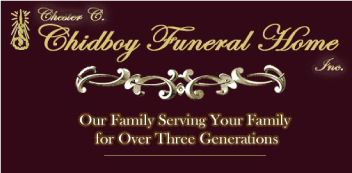365 Days of Grief & Healing

Curwensville Location History
The History of Chidboy Funeral Home, Curwensville
 The history of the building which houses the Chester C. Chidboy Funeral Home, Inc. basically starts with the founding of the town of Curwensville.
The history of the building which houses the Chester C. Chidboy Funeral Home, Inc. basically starts with the founding of the town of Curwensville.
The building was built by Lt. Col. Edwin A. Irvin just prior to the start of the Civil War. Mr. Irvin’s family had originally laid out the first streets in Curwensville, and had made their fortune in lumber, a saw mill, and land holdings, and later had operated a grist mill and general store in town.
Edwin was working in the family business (timber) and had completed the main part of the house in 1860. His parent’s house was located right Locust Street which is now owned by Hildred and Carolyn Rowles (a.k.a. The Strawberry Tree). The original property extended from Locust St. to Filbert St.
After serving as a Captain and rising to the rank of Lt. Col. with Co. K of the 42nd Inf. Reg., Edwin returned to Curwensville and resumed his roll in the family business. Late in the 1890’s, the rear portion of the present building was constructed and remains the same as it was to this day. The only change was to the roof line of the rear addition which was changed from a twin peaked roof with a valley to the single “A” gable which you see today.
Edwin past away in 1908 and the property holdings fell to his son Hugh. The original wrought iron front porch was removed and the large wrap around porch which you see today was done while Hugh owned the building. Hugh Irvin continued to own the house until the stock market crash of 1929, and due to financial problems, the property was eventually sold.
Dr. Elmo Erhard purchased the property and operated his medical practice in it until the late 1940’s when he purchased the building across the street, The Dyer House, and moved his practice there. A dentist had also operated his practice up in the second floor while Dr. Erhard used the first floor. It was during this time that the remainders of the second and third floors were remodeled into apartments (4 in all).
After Dr. Erhard moved his practice across the street, the first floor remained empty and the apartments remained on the second and third floors. In May of 1952, Dr. Erhard sold the property to Mr. Chester C. Chidboy, then of Glen Campbell, Cambria County, and after a year of cleaning, fixing, and some remodeling, Mr. Chidboy and his wife Martha Jane (Kibler) Chidboy opened the Chester C. Chidboy Funeral Home on April 11, 1953. The business was later Incorporated in 1980.
The floor plan of the original building has not changed much since it was built. The only major change was that the library and dining rooms on the right side entering the front of the building were combined into one large room. Also at one time there were 9 working fireplaces in the building and you can still see 4 of them but only one still works, and that is the one in the office area.
The only other major changes to the building was that the original building built in 1860 never had a basement, but in 1975, that was changed and the building has a complete basement underneath it, and in the 1960’s, a parking lot was added to the side of the building.
The original property also had a barn located where the Verizon building now stands, but it was torn down in the 1960’s because structurally, it was in a very poor condition.
The building is now owned by Mr. Chidboy’s daughter Shelia and her husband Bill Williams who continue to operate the Chester C. Chidboy Funeral Home, Inc. along with their daughter Shaina and her husband Dave Franson.
Some other facts about the Chidboy Funeral Home Property:
1. It has been said that this building was being used as part of the Underground Railroad.
2. There is a gunshot hole in one of the plate glass windows facing the stoplight, placed there by Col. Irvin.
3. It is probably the 3rd oldest home in Curwensville behind the Dyer house (across the street) and the Strawberry Tree. 4. It was the first building in Curwensville to have indoor plumbing.
5. Col. Irwin was wounded 8 times before having to take a medical discharge in 1963.
6. Most of the outer and inside walls are approx 1 foot thick and constructed of solid brick from the basement stone foundation to the floor level of the third floor with 3” x 14” floor joists spanning the exterior and interior walls.
7. The approximate cost to build this building in 1860 was $10,000.00, and Col Irvin hired carpenters and masons from as far away as Philadelphia.
8. The son of the Architect who designed the William Irvin home designed Col. Irvin’s home which is why the front entrance and front hallway are similar.
